jump start CHEVROLET SSR 2004 1.G Owners Manual
[x] Cancel search | Manufacturer: CHEVROLET, Model Year: 2004, Model line: SSR, Model: CHEVROLET SSR 2004 1.GPages: 398, PDF Size: 2.49 MB
Page 257 of 398

Service............................................................5-3
Doing Your Own Service Work.........................5-3
Adding Equipment to the Outside
of Your Vehicle...........................................5-4
Fuel................................................................5-4
Gasoline Octane............................................5-5
Gasoline Speci�cations....................................5-5
California Fuel...............................................5-5
Additives.......................................................5-6
Fuels in Foreign Countries...............................5-6
Filling Your Tank............................................5-7
Filling a Portable Fuel Container.......................5-9
Checking Things Under the Hood....................5-10
Hood Release..............................................5-10
Engine Compartment Overview.......................5-12
Engine Oil...................................................5-13
Engine Cover...............................................5-18
Engine Air Cleaner/Filter................................5-19
Automatic Transmission Fluid.........................5-20
Engine Coolant.............................................5-23
Coolant Surge Tank Pressure Cap..................5-26
Engine Overheating.......................................5-26
Cooling System............................................5-28
Power Steering Fluid.....................................5-31
Windshield Washer Fluid................................5-31Brakes........................................................5-33
Battery........................................................5-36
Jump Starting...............................................5-37
Rear Axle.......................................................5-43
Headlamp Aiming...........................................5-43
Bulb Replacement..........................................5-43
Halogen Bulbs..............................................5-44
Headlamps..................................................5-44
Front Turn Signal, Sidemarker
and Parking Lamps....................................5-45
Center High-Mounted Stoplamp (CHMSL).........5-47
Taillamps.....................................................5-47
Back-Up Lamps............................................5-48
Replacement Bulbs.......................................5-48
Windshield Wiper Blade Replacement..............5-49
Tires..............................................................5-51
In�ation - Tire Pressure.................................5-58
Tire Inspection and Rotation...........................5-59
When It Is Time for New Tires.......................5-60
Buying New Tires.........................................5-60
Uniform Tire Quality Grading..........................5-61
Wheel Alignment and Tire Balance..................5-63
Wheel Replacement......................................5-63
Section 5 Service and Appearance Care
5-1
Page 269 of 398
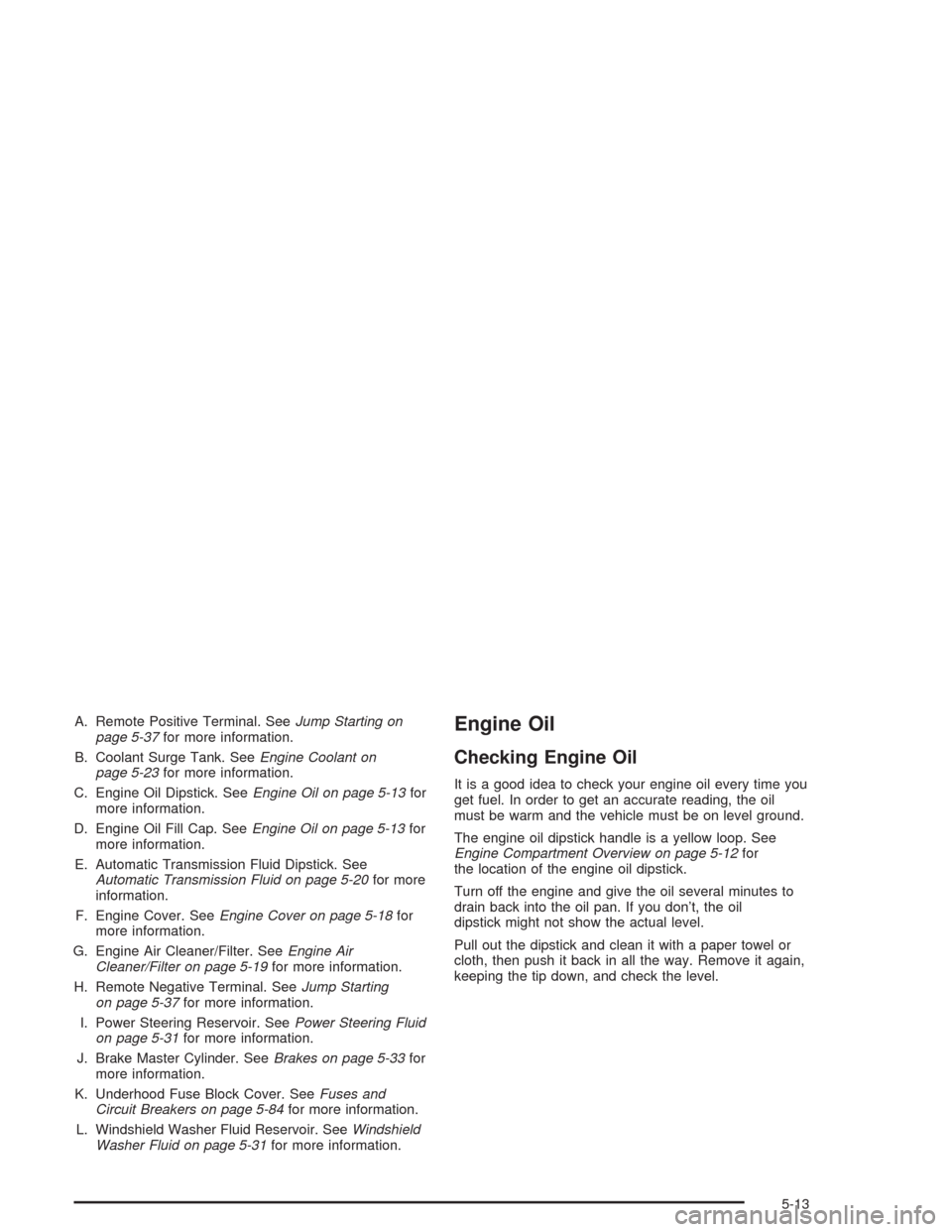
A. Remote Positive Terminal. SeeJump Starting on
page 5-37for more information.
B. Coolant Surge Tank. SeeEngine Coolant on
page 5-23for more information.
C. Engine Oil Dipstick. SeeEngine Oil on page 5-13for
more information.
D. Engine Oil Fill Cap. SeeEngine Oil on page 5-13for
more information.
E. Automatic Transmission Fluid Dipstick. See
Automatic Transmission Fluid on page 5-20for more
information.
F. Engine Cover. SeeEngine Cover on page 5-18for
more information.
G. Engine Air Cleaner/Filter. SeeEngine Air
Cleaner/Filter on page 5-19for more information.
H. Remote Negative Terminal. SeeJump Starting
on page 5-37for more information.
I. Power Steering Reservoir. SeePower Steering Fluid
on page 5-31for more information.
J. Brake Master Cylinder. SeeBrakes on page 5-33for
more information.
K. Underhood Fuse Block Cover. SeeFuses and
Circuit Breakers on page 5-84for more information.
L. Windshield Washer Fluid Reservoir. SeeWindshield
Washer Fluid on page 5-31for more information.Engine Oil
Checking Engine Oil
It is a good idea to check your engine oil every time you
get fuel. In order to get an accurate reading, the oil
must be warm and the vehicle must be on level ground.
The engine oil dipstick handle is a yellow loop. See
Engine Compartment Overview on page 5-12for
the location of the engine oil dipstick.
Turn off the engine and give the oil several minutes to
drain back into the oil pan. If you don’t, the oil
dipstick might not show the actual level.
Pull out the dipstick and clean it with a paper towel or
cloth, then push it back in all the way. Remove it again,
keeping the tip down, and check the level.
5-13
Page 293 of 398
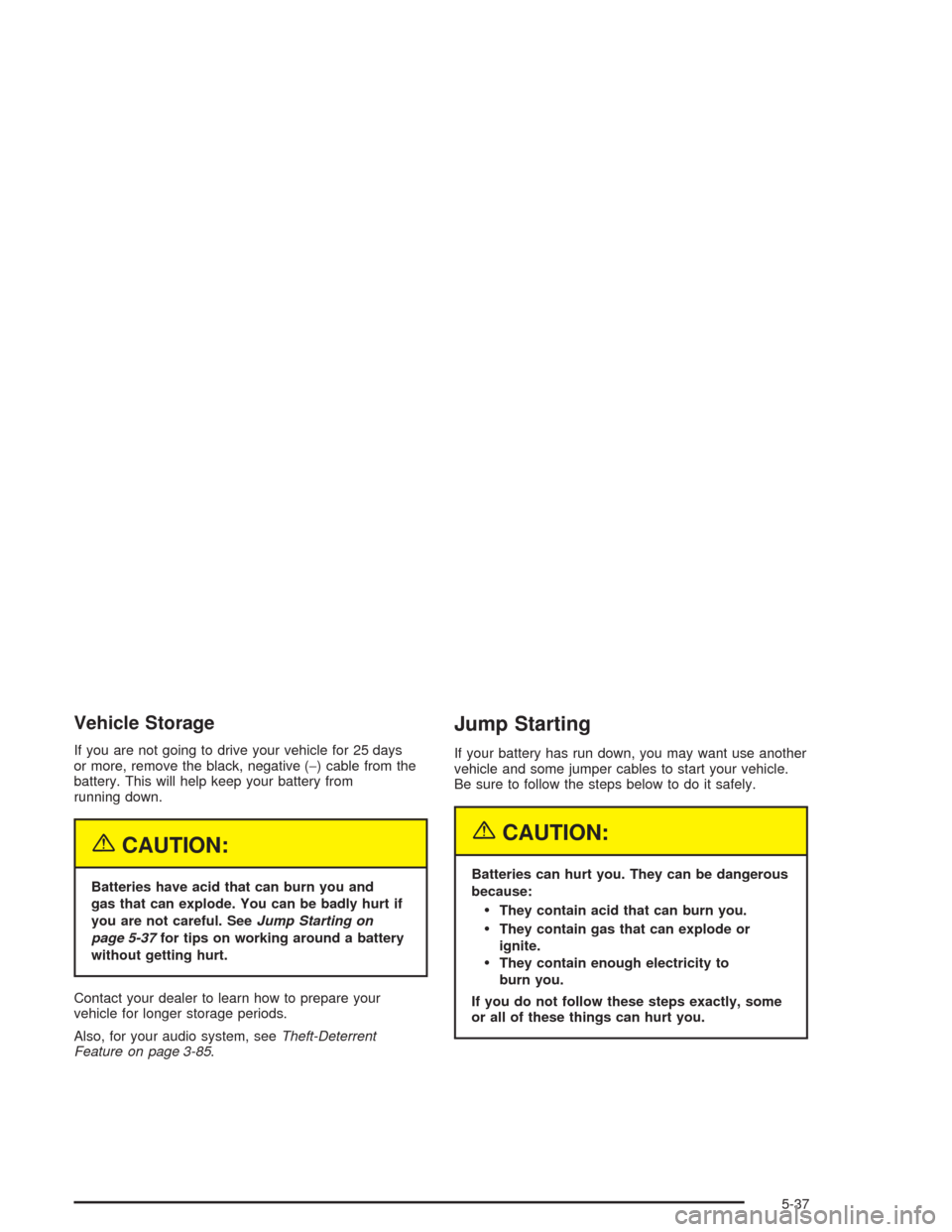
Vehicle Storage
If you are not going to drive your vehicle for 25 days
or more, remove the black, negative (−) cable from the
battery. This will help keep your battery from
running down.
{CAUTION:
Batteries have acid that can burn you and
gas that can explode. You can be badly hurt if
you are not careful. SeeJump Starting on
page 5-37for tips on working around a battery
without getting hurt.
Contact your dealer to learn how to prepare your
vehicle for longer storage periods.
Also, for your audio system, seeTheft-Deterrent
Feature on page 3-85.
Jump Starting
If your battery has run down, you may want use another
vehicle and some jumper cables to start your vehicle.
Be sure to follow the steps below to do it safely.
{CAUTION:
Batteries can hurt you. They can be dangerous
because:
They contain acid that can burn you.
They contain gas that can explode or
ignite.
They contain enough electricity to
burn you.
If you do not follow these steps exactly, some
or all of these things can hurt you.
5-37
Page 294 of 398
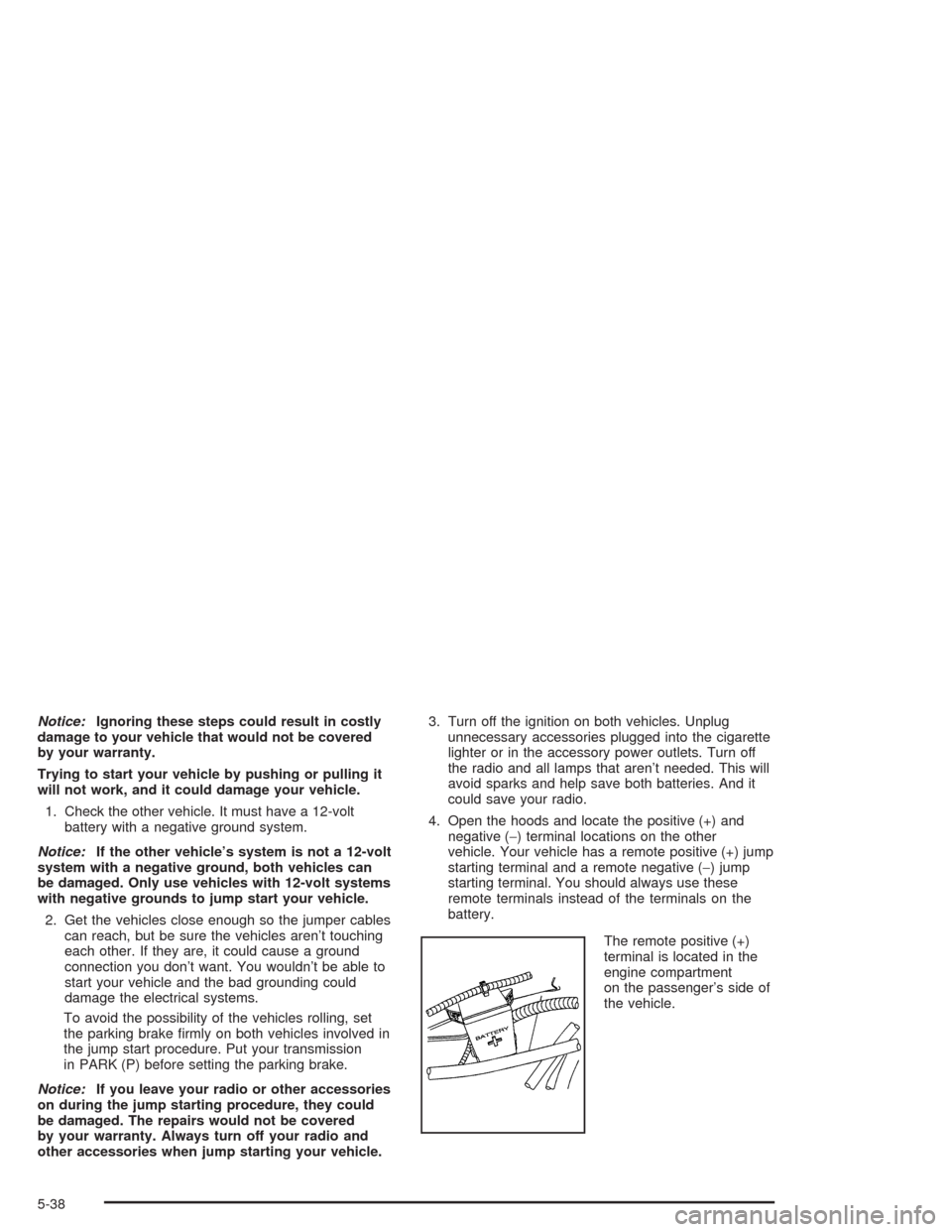
Notice:Ignoring these steps could result in costly
damage to your vehicle that would not be covered
by your warranty.
Trying to start your vehicle by pushing or pulling it
will not work, and it could damage your vehicle.
1. Check the other vehicle. It must have a 12-volt
battery with a negative ground system.
Notice:If the other vehicle’s system is not a 12-volt
system with a negative ground, both vehicles can
be damaged. Only use vehicles with 12-volt systems
with negative grounds to jump start your vehicle.
2. Get the vehicles close enough so the jumper cables
can reach, but be sure the vehicles aren’t touching
each other. If they are, it could cause a ground
connection you don’t want. You wouldn’t be able to
start your vehicle and the bad grounding could
damage the electrical systems.
To avoid the possibility of the vehicles rolling, set
the parking brake �rmly on both vehicles involved in
the jump start procedure. Put your transmission
in PARK (P) before setting the parking brake.
Notice:If you leave your radio or other accessories
on during the jump starting procedure, they could
be damaged. The repairs would not be covered
by your warranty. Always turn off your radio and
other accessories when jump starting your vehicle.3. Turn off the ignition on both vehicles. Unplug
unnecessary accessories plugged into the cigarette
lighter or in the accessory power outlets. Turn off
the radio and all lamps that aren’t needed. This will
avoid sparks and help save both batteries. And it
could save your radio.
4. Open the hoods and locate the positive (+) and
negative (−) terminal locations on the other
vehicle. Your vehicle has a remote positive (+) jump
starting terminal and a remote negative (−) jump
starting terminal. You should always use these
remote terminals instead of the terminals on the
battery.
The remote positive (+)
terminal is located in the
engine compartment
on the passenger’s side of
the vehicle.
5-38
Page 295 of 398

Press inward on the tabs located on the outboard
sides of the remote positive (+) terminal cover
and pull outward to access the terminal.
The remote negative (−) terminal is located near the
power steering �uid reservoir. It is marked
“GND (−).” SeeEngine Compartment Overview on
page 5-12for more information on location.
You will not see the battery of your vehicle under
the hood. It is located on the rear underside of
the vehicle. You will not need to access the battery
for jump starting. The remote positive (+) terminal
is for that purpose.
{CAUTION:
An electric fan can start up even when the
engine is not running and can injure you.
Keep hands, clothing and tools away from any
underhood electric fan.
{CAUTION:
Using a match near a battery can cause battery
gas to explode. People have been hurt doing
this, and some have been blinded. Use a
�ashlight if you need more light.
Be sure the battery has enough water. You do
not need to add water to the ACDelco
®battery
installed in your new vehicle. But if a battery
has �ller caps, be sure the right amount of
�uid is there. If it is low, add water to take care
of that �rst. If you do not, explosive gas could
be present.
Battery �uid contains acid that can burn you.
Do not get it on you. If you accidentally get it
in your eyes or on your skin, �ush the place
with water and get medical help immediately.
5-39
Page 297 of 398
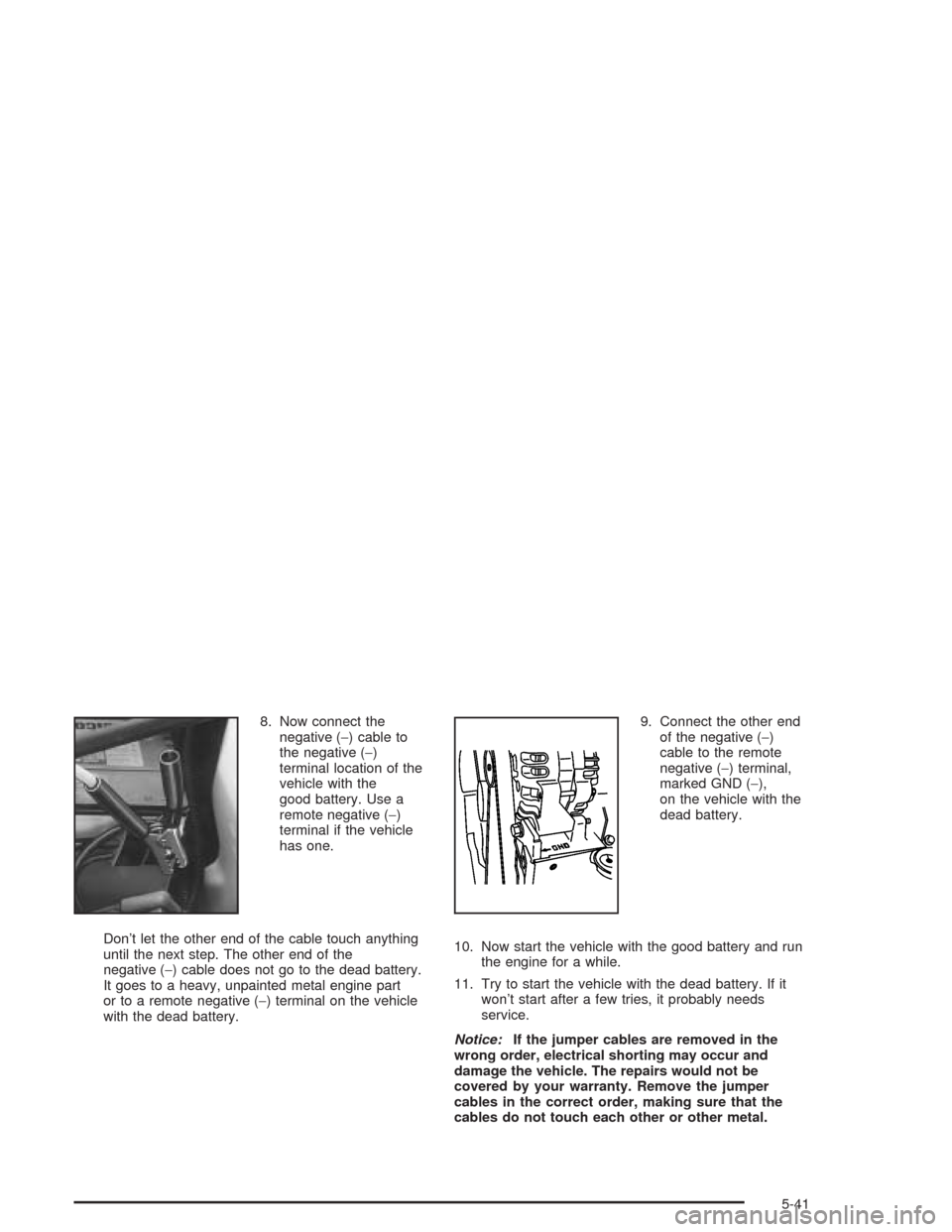
8. Now connect the
negative (−) cable to
the negative (−)
terminal location of the
vehicle with the
good battery. Use a
remote negative (−)
terminal if the vehicle
has one.
Don’t let the other end of the cable touch anything
until the next step. The other end of the
negative (−) cable does not go to the dead battery.
It goes to a heavy, unpainted metal engine part
or to a remote negative (−) terminal on the vehicle
with the dead battery.9. Connect the other end
of the negative (−)
cable to the remote
negative (−) terminal,
marked GND (−),
on the vehicle with the
dead battery.
10. Now start the vehicle with the good battery and run
the engine for a while.
11. Try to start the vehicle with the dead battery. If it
won’t start after a few tries, it probably needs
service.
Notice:If the jumper cables are removed in the
wrong order, electrical shorting may occur and
damage the vehicle. The repairs would not be
covered by your warranty. Remove the jumper
cables in the correct order, making sure that the
cables do not touch each other or other metal.
5-41
Page 375 of 398
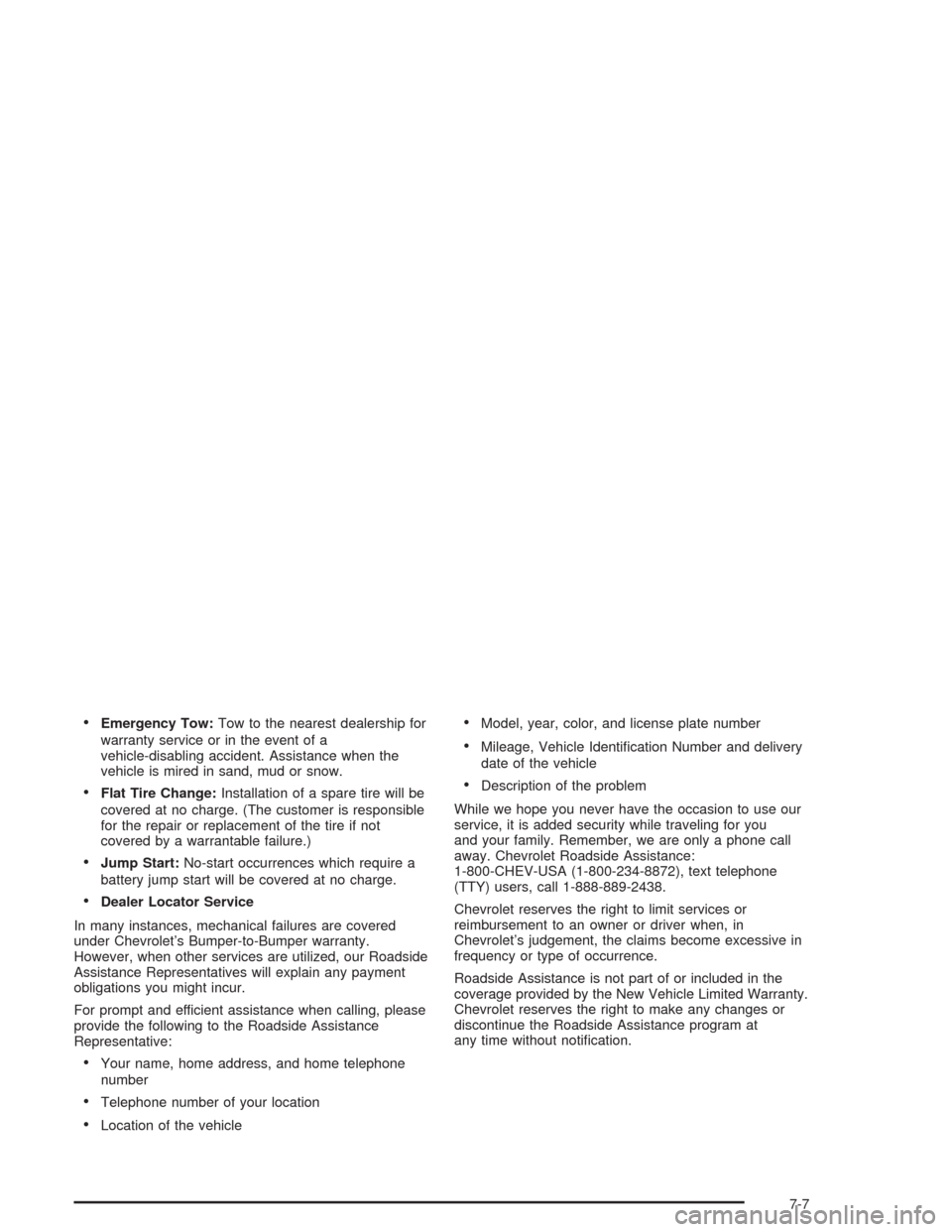
Emergency Tow:Tow to the nearest dealership for
warranty service or in the event of a
vehicle-disabling accident. Assistance when the
vehicle is mired in sand, mud or snow.
Flat Tire Change:Installation of a spare tire will be
covered at no charge. (The customer is responsible
for the repair or replacement of the tire if not
covered by a warrantable failure.)
Jump Start:No-start occurrences which require a
battery jump start will be covered at no charge.
Dealer Locator Service
In many instances, mechanical failures are covered
under Chevrolet’s Bumper-to-Bumper warranty.
However, when other services are utilized, our Roadside
Assistance Representatives will explain any payment
obligations you might incur.
For prompt and efficient assistance when calling, please
provide the following to the Roadside Assistance
Representative:
Your name, home address, and home telephone
number
Telephone number of your location
Location of the vehicle
Model, year, color, and license plate number
Mileage, Vehicle Identi�cation Number and delivery
date of the vehicle
Description of the problem
While we hope you never have the occasion to use our
service, it is added security while traveling for you
and your family. Remember, we are only a phone call
away. Chevrolet Roadside Assistance:
1-800-CHEV-USA (1-800-234-8872), text telephone
(TTY) users, call 1-888-889-2438.
Chevrolet reserves the right to limit services or
reimbursement to an owner or driver when, in
Chevrolet’s judgement, the claims become excessive in
frequency or type of occurrence.
Roadside Assistance is not part of or included in the
coverage provided by the New Vehicle Limited Warranty.
Chevrolet reserves the right to make any changes or
discontinue the Roadside Assistance program at
any time without noti�cation.
7-7
Page 390 of 398

J
Jump Starting.................................................5-37
K
Keyless Entry System....................................... 2-3
Keys............................................................... 2-2
L
Lamps
Exterior......................................................3-12
Interior.......................................................3-15
Lamps On Reminder.......................................3-13
Lap-Shoulder Belt...........................................1-12
LATCH System
Child Restraints...........................................1-32
Securing a Child Restraint Designed for the
LATCH System........................................1-34
Latches, Seatback............................................ 1-6
Leaving Your Vehicle......................................... 2-8
Leaving Your Vehicle With the Engine Running . . . 2-20Light
Air Bag Off .................................................3-28
Air Bag Readiness.......................................3-26
Anti-Lock Brake System Warning...................3-31
Brake System Warning.................................3-30
Change Engine Oil......................................3-37
Charging System.........................................3-29
Check Gages Warning.................................3-39
Cruise Control.............................................3-38
Highbeam On.............................................3-39
Malfunction Indicator....................................3-32
Reduced Engine Power................................3-38
Safety Belt Reminder...................................3-26
Security.....................................................3-37
TCS Warning Light......................................3-31
Traction Control System (TCS) Warning..........3-31
Lighted Visor Vanity Mirrors..............................2-11
Loading Your Vehicle.......................................4-32
Locks
Door........................................................... 2-6
Leaving Your Vehicle..................................... 2-8
Power Door.................................................. 2-7
Programmable Automatic Door Locks............... 2-8
Loss of Control...............................................4-15
8